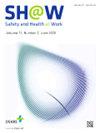跨现实的职业健康与安全培训:剪刀项目的初步结果
IF 2.9
3区 医学
Q1 PUBLIC, ENVIRONMENTAL & OCCUPATIONAL HEALTH
引用次数: 0
摘要
职业健康与安全(OHS)培训是工作场所安全的重要组成部分。近年来,跨现实(XR)已经成为沉浸式成功培训体验的可行途径。本文介绍了SCISSOR项目的初步结果,这是一个开创性的倡议,探索XR技术在加强职业健康安全培训方面的潜力,特别是在医疗保健环境中关于电离辐射暴露的培训。材料和方法本准实验性先导研究由2021年7月至2022年6月的几个阶段组成。第一阶段是虚拟场景的实现,第二阶段是XR设置和实验室仿真,第三阶段是基于现场测试。结果约60名学生和科研人员参加了第一阶段和第二阶段的初步检测,9名医护人员参加了第三阶段的初步检测。第一阶段涉及使用数字摄影测量技术对现实场景进行3D重建。然后利用这些模型来重建手术室场景和与设备的程序交互。在阶段2中,对应用程序的现实性、舒适性和可用性的总体评价进行了调查。测试结果表明了对该应用程序及其有效性的普遍赞赏。第三阶段涉及现场试验,涉及卫生武器。结果表明,XR技术在彻底改变职业安全与健康培训方面具有重大前景,为工作场所安全教育提供了一种更有吸引力、更有效、更适应性的方法。SCISSOR项目的初步发现强调了XR作为职业健康安全培训变革工具的潜力,最终有助于更安全的工作场所,减少事故,提高员工的整体福祉。本文章由计算机程序翻译,如有差异,请以英文原文为准。
Occupational Health and Safety Training by Cross-Reality: Preliminary Results From SCISSOR Project
Background
Occupational Health and Safety (OHS) training is a crucial component of workplace safety. In recent years, Cross-reality (XR) has emerged as a viable path for immersive and successful training experiences. This paper presents preliminary results from the SCISSOR project, a groundbreaking initiative exploring the potential of XR technologies in enhancing OHS training, especially in healthcare setting regarding ionization radiation exposure.
Materials and methods
This quasi-experimental pilot study consisted of several stages from July 2021 to June 2022. Phase 1 consists of the realization of the virtual scenario, Phase 2 in XR setting up and laboratory simulation, and lastly, and Phase 3 based on the on field testing.
Results
About 60 participants, including students and researchers, participated in Phases 1 and 2 preliminary testing and 9 healthcare workers (HCWs) in Phase 3. Phase 1 involved the 3D reconstruction of a real-life scenario using digital photogrammetry. These models were then utilized to recreate the operating room scenario and program interactions with the equipment. In Phase 2, the overall appreciation for the level of realism, comfort, and usability of the application was investigated. The test results demonstrated a general appreciation for the application and its effectiveness. Phase 3, concerning field tests, involved HCWs. The results suggest that XR technologies hold significant promise in revolutionizing OHS training, offering a more engaging, effective, and adaptable approach to workplace safety education.
Conclusion
The SCISSOR project’s initial findings underscore the potential of XR as a transformative tool in OHS training, ultimately contributing to safer workplaces, reduced accidents, and enhanced overall employee well-being.
求助全文
通过发布文献求助,成功后即可免费获取论文全文。
去求助
来源期刊

Safety and Health at Work
Social Sciences-Safety Research
CiteScore
6.40
自引率
5.70%
发文量
1080
审稿时长
38 days
期刊介绍:
Safety and Health at Work (SH@W) is an international, peer-reviewed, interdisciplinary journal published quarterly in English beginning in 2010. The journal is aimed at providing grounds for the exchange of ideas and data developed through research experience in the broad field of occupational health and safety. Articles may deal with scientific research to improve workers'' health and safety by eliminating occupational accidents and diseases, pursuing a better working life, and creating a safe and comfortable working environment. The journal focuses primarily on original articles across the whole scope of occupational health and safety, but also welcomes up-to-date review papers and short communications and commentaries on urgent issues and case studies on unique epidemiological survey, methods of accident investigation, and analysis. High priority will be given to articles on occupational epidemiology, medicine, hygiene, toxicology, nursing and health services, work safety, ergonomics, work organization, engineering of safety (mechanical, electrical, chemical, and construction), safety management and policy, and studies related to economic evaluation and its social policy and organizational aspects. Its abbreviated title is Saf Health Work.
 求助内容:
求助内容: 应助结果提醒方式:
应助结果提醒方式:


